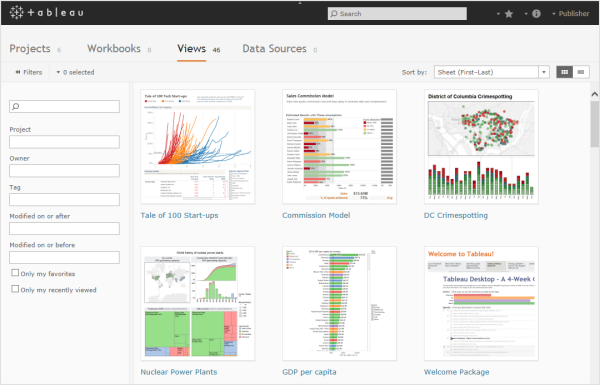Tableau Server 9.0 Makes Permissions & Automation Easier To Manage
Tableau Server 9.0 makes it easier to unleash the power of data across an entire organization, from an administrator to an IT developer, to an end user.
Here’s an overview of the new and improved features.
We’ve rebuilt the Server from the ground up using AngularJS, Java, and a services-oriented architecture. The result: a faster and richer user experience.
Content Management
When you log in as an administrator, you’ll see the revamped content management section. We’ve replaced pagination with infinite scrolling, which makes browsing through content a breeze. And the Universal Search feature helps you quickly locate workbooks, users, and data sources. Both features are powered by Solr, the search platform behind many of the world's largest Internet sites.

Relevant Actions
In Tableau Server 9.0, you can perform bulk operations against multiple items, or perform specific actions against a single item. The list of available actions is updated depending on your selection context. For example, if you select multiple data sources, the actions specific to the selection context will be enabled, as seen in the example below. The “more” drop-down menu shows additional actions available on the selected items.

Actions that perform bulk operations have built-in permission checks. If a user tries to apply an unpermitted action, an error message will pop up.
For an action on a single selected item, the Server checks your permissions and updates the state of the menu items. If you don’t have permission to perform an action, the menus are disabled. For instance, in the example below, you can see that “edit connection” is disabled.

We’ve visualized user permissions to make management easier. In Tableau Server 9.0, you can tell at a glance which user has which permissions. Hover over the permission box, and you can see why the user has that specific permission.

You can also add a new user or a new group and assign permissions without navigating away from the permissions view. Changing permissions is as easy as clicking on the appropriate box. Once you click, the box will turn green and a checkmark will appear, indicating the user has been given permission.
The new Server Analytics views provide insights into Tableau usage in your organization. For example, if you want to know how many people are using the server at any given time (because you want to know whether you should reboot the server), you can find the answer very quickly on the “Actions by All Users” view.

You can interact with these views and find answers to additional questions like: What are the most popular views? Who accesses these views most frequently? Which data sources are most widely used? Who uses them most often? And which users take up the most space on Tableau Server? (Learn more about these views.)
In Tableau Server 9.0, you can automate business processes using the new REST API. For example, you can build a script to automatically onboard new users or even entire teams. Use your script to create a site, create a project, assign permissions, and publish starter content for the user, all as part of the single onboarding program.
Leveraging a standard REST API, along with JavaScript and data APIs, gives your developers a simple, flexible, and easy-to-understand set of tools to enhance Tableau Server capabilities. How will you use these APIs? Let us know.
Tableau Server 9.0 has a number of updates including parallel plans, query fusion, shared query caching, support for vectorization, and temp tables on data server. In many cases, these updates significantly improve performance. (Read more about these features.)
Tableau is a workhorse that requires system resource to do a lot of the work before it can service end-user requests with beautiful visualizations. However, there may be occasions when you run low on system resources. We wanted to minimize service interruptions during these times. So we've added Server Resource Monitoring tokeep track of the CPU and memory utilization of key server processes like VizQL Server.
While this doesn't preclude having a sound infrastructure monitoring plan in place, this feature will attempt to auto-correct health issues by restarting affected server processes and alerting you.
We've just scratched the surface of Tableau Server 9.0, which takes things to a #WholeNewLevel. We've made huge improvements to the High Availability architecture, including adding cluster management capabilities. We'll highlight some of those upgrades in an upcoming post.
Want to Learn More?
Check out the rest of our Tableau 9.0 blog series:


